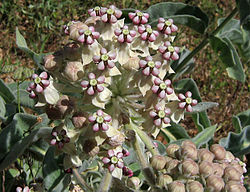From Wikipedia
Open on Wikipedia
| Asclepias eriocarpa | |
|---|---|

| |
| Scientific classification | |
| Kingdom: | Plantae |
| Clade: | Tracheophytes |
| Clade: | Angiosperms |
| Clade: | Eudicots |
| Clade: | Asterids |
| Order: | Gentianales |
| Family: | Apocynaceae |
| Genus: | Asclepias |
| Species: | A. eriocarpa
|
| Binomial name | |
| Asclepias eriocarpa | |
| Synonyms | |
|
Asclepias fremontii | |
Asclepias eriocarpa is a species of milkweed known by the common names woollypod milkweed, Indian milkweed, and kotolo. It is a perennial herb that grows in many types of habitats.
Description
[edit]Asclepias eriocarpa is an erect perennial herb which is usually coated in a thick layer of white hairs. The leaves are lance-shaped to oval, rippled, and arranged oppositely in pairs or in whorls of 3 or 4. The inflorescence is a large umbel-like cluster of flowers. Each flower is white to cream and usually tinted with bright pink. It has a central array of rounded hoods and a corolla reflexed against the stalk. The fruit is a large, woolly follicle. Flowers bloom May to October.[2]
Distribution and habitat
[edit]Asclepias eriocarpa is native to California and adjacent parts of Nevada and Baja California. It grows in many habitat types such as rocky hillsides, woods, deserts, and especially dry areas.[2]
Uses
[edit]The plant was used as a source of fiber and medicine by several California Indian groups, including the Ohlone and Luiseño.[3] The Concow tribe calls the plant bō'-kō (Konkow language).[4]
Ecology
[edit]Asclepias eriocarpa is a specific monarch butterfly food and habitat plant. It is one of the most poisonous milkweeds. Natural History July/August 2015 calls it the most poisonous, but most sources put it below A. lancifolia (now known as Asclepias perennis).[dubious – discuss]
References
[edit]- ^ "NatureServe Explorer - Asclepias eriocarpa". NatureServe Explorer Asclepias eriocarpa. NatureServe. 2022-05-30. Retrieved 30 May 2022.
- ^ a b "Lady Bird Johnson Wildflower Center - The University of Texas at Austin". www.wildflower.org. Retrieved 2022-03-18.
- ^ Ethnobotany
- ^ Chesnut, Victor King (1902). Plants used by the Indians of Mendocino County, California. Government Printing Office. p. 404. Retrieved 24 August 2012.
